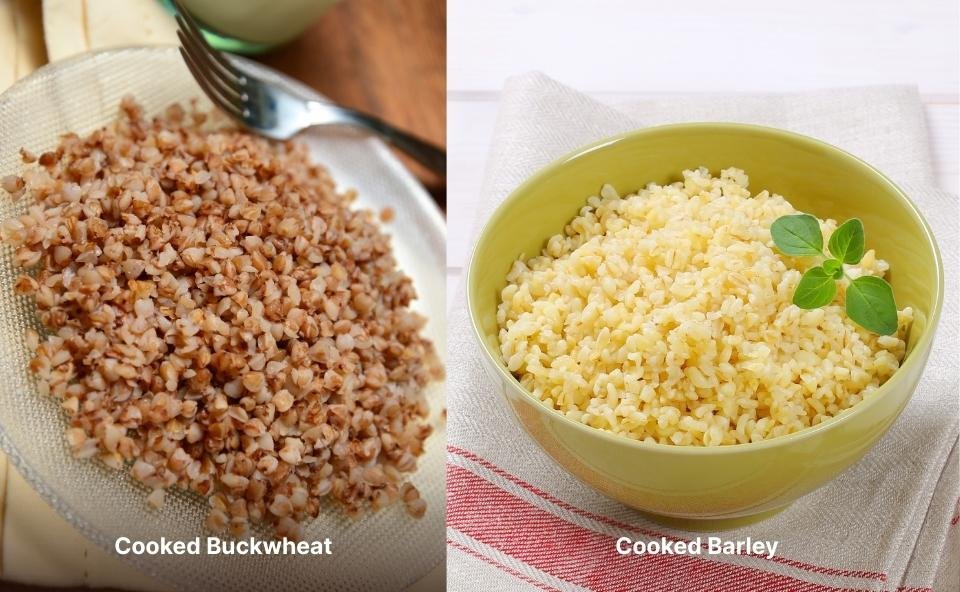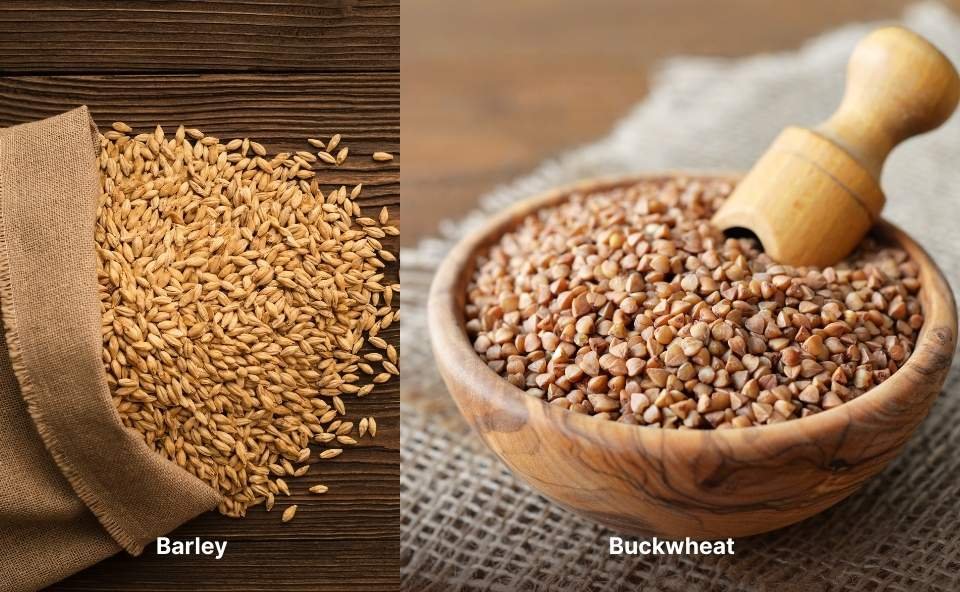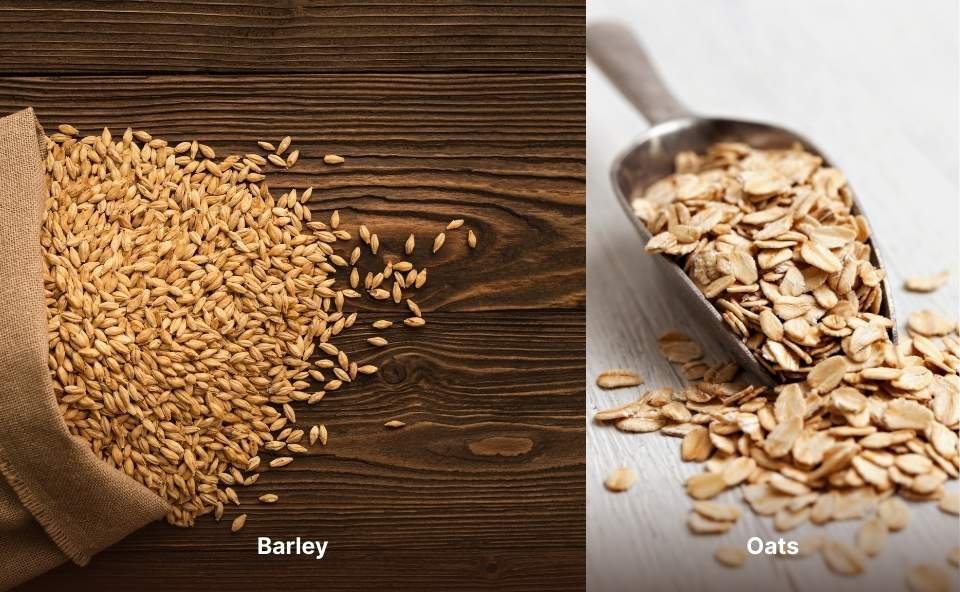As someone who enjoys working with whole grains, I’ve spent time exploring buckwheat and barley—not because they look alike (they don’t!), but because each brings something special. The differences in their traits and nutritional information show once you use them in authentic recipes.
Buckwheat is naturally gluten-free, making it an excellent choice for a gluten-free diet or anyone with celiac disease. It’s also packed with magnesium, low in calories, and gentle on your glycemic index, which helps keep insulin levels steady.
Barley, though not suitable for gluten-sensitive folks, shines in other areas. It’s rich in dietary fiber, vitamin B3, and selenium, which support digestion and heart health. However, it does have a higher glycemic impact.
I’ve tried both in all sorts of recipes, and what really sets them apart is how they fit into different lifestyles. This quick guide will help you solve the mystery and decide which grain is healthier.
But before we jump into the details, let’s quickly refresh our memories on what makes each grain unique.
🌾What is Buckwheat?
I first discovered buckwheat when I was exploring healthier recipes. It’s actually not a grain but a pseudocereal—a seed that cooks up like a grain. Originally cultivated in Southeast Asia about 6,000 years ago, it’s now enjoyed worldwide. One of the best things about buckwheat is that it’s gluten-free, so it’s perfect for anyone with gluten intolerance or following a restricted diet. For a more detailed understanding, check out my Buckwheat Guide!
Buckwheat comes in different varieties, like Common buckwheat, Tartary buckwheat, and perennial buckwheat. These belong to the Fagopyrum genus and Polygonaceae family, with well-known species like Fagopyrum esculentum and Fagopyrum tataricum. You can eat it as the whole kernel or ground it into flour—I love adding it to both sweet and savory dishes for variety!
🌾What is Barley?
I’ve always loved barley’s nutty flavor and chewy texture. It’s been a dietary staple for centuries, one of the earliest-grown grains full of nutrients and dietary fiber. Whether in soups, salads, or barley porridge, its versatility makes it a favorite in many culinary applications. Plus, it’s used in alcoholic beverages and as animal feed.
Different varieties include hulled barley, pearl barley, and quick barley. I often find pearl barley in U.S. grocery stores. It belongs to the Hordeum genus and comes in types like Six-row barley and Two-row barley, each offering unique benefits for cooking.
Let’s compare these two amazing grains! Now that we’ve explored both, it’s time to compare them head-to-head.
👀Appearance
As someone who’s explored many whole grains, I was instantly drawn to the appearance of both Buckwheat and barley. Holding a pile of dried seeds felt like discovering nature’s tiny art.
Buckwheat, with its triangular heart shape and grey or dark brown rind, looks earthy and charming in its warm brown tone. Meanwhile, barley is round, small, and shaped like rice grains, usually pale tan but sometimes showing various colors from light to dark reddish-brown.
🥄Taste
In my experience, barley has a mild, nutty flavor, perfect for lighter meals. On the other hand, buckwheat has a more pungent taste that’s bitter and sour, similar to whole-wheat flour or rye.
When cooked, buckwheat becomes mushy, while barley is more sticky but not as soft. Both are great, but it depends on how bold you like your grains.

Side-by-side image of cooked buckwheat and barley, highlighting their texture and appearance.
💪Buckwheat vs. Barley: Nutrition Breakdown
If you’re like me and love mixing up your whole grains, buckwheat and barley are two powerhouse picks I’ve come to appreciate. They’re nutrient-dense, plant-based, and super versatile in meals, but they shine differently depending on your health goals and preferences.
Buckwheat: The Gluten-Free Protein Star🌱
- Perfect for Gluten-Free Diets: Buckwheat is naturally gluten-free—no gliadin, no glutenin—so it’s my go-to when I want something easy on the gut.
- A Fiber-Rich Choice: At about 3.38g of fiber per 100g, it helps keep digestion smooth and keeps you fuller longer.
- Complete Plant Protein: With 13g of protein and all nine essential amino acids (like lysine, threonine, and tryptophan), buckwheat holds its own for muscle and tissue support.
- Loaded with Minerals: Magnesium (92mg), copper, manganese, phosphorus, and selenium—buckwheat has them all, fueling your metabolism and nerve function.
- Great for Blood Sugar Balance: Its low glycemic index and load make it a steady energy source, perfect for supporting blood sugar and insulin.
- Low in Fat, High in Heart Health: It’s nearly fat-free (just 1g per 100g) and contains the good kind—mono- and polyunsaturated fats.
- B Vitamin Boost: Buckwheat offers B3, B5, and even B12, which support metabolism and mental clarity.
- Calories That Work for You: Depending on how it’s cooked, 100–154 calories per serving are light but satisfying.
Barley: The Heart-Loving, Hearty Classic🌾
- Contains Gluten: Unlike buckwheat, barley contains gliadin, so it’s not an option for gluten-free diets, but it’s still a deeply nourishing grain.
- Fiber-Packed and Filling: With 2.7g fiber per 100g (primarily beta-glucans), barley helps with gut health and lowering cholesterol.
- Good Protein Support: It has around 10g of protein. This is not a complete profile, but it greatly contributes to daily intake, especially in a plant-based diet.
- Mineral-Dense Like Buckwheat: You’ll find the same mineral punch here for bone and enzyme health: Phosphorus, magnesium, manganese, and copper.
- Cardio-Friendly and Cholesterol-Free: Barley is known for its heart benefits, especially in lowering LDL cholesterol.
- Slow-Burn Carbs, Low Fat: Complex carbs give lasting energy, and fat stays at about 1g, mostly healthy unsaturated.
- Low-Calorie and Satisfying: You get 100–123 calories per 100g, depending on how it’s prepared. Filling without being heavy.
- Micronutrient Rich: Barley brings essential micronutrients for immune support and energy metabolism.
Both grains bring so much to the table. Buckwheat is perfect if you’re going gluten-free or need more complete protein. Barley, on the other hand, is a fiber champ with deep roots in traditional cooking. I like to mix them into different meals for variety and balance. They’re a fantastic combo for weight goals, heart health, and overall well-being.
✅ Sources:
🩸Glycemic Index Score
In my own meals, I’ve found barley to be the better choice when watching blood sugar. Its glycemic index (GI) score is just 28—one of the lowest among grains—so it doesn’t cause much glucose spike. That steady energy is something I really appreciate.
However, buckwheat falls between 45 and 55 on the glycemic index, depending on preparation. It’s still considered low GI (GI<55), but I’ve noticed it has a slightly more substantial effect on blood sugar.
Either way, both are great food options—it depends on what your body responds to best.
🧬 Diet-Friendly Grain Choices
In my own diet journey, I’ve often compared buckwheat and barley. While barley is a grain, buckwheat is a pseudocereal, making it Paleo-friendly and a fit for the Paleo diet, unlike barley, which is not allowed. Both are packed with nutrients but have high carb content, so they’re not keto-friendly. Buckwheat is better if you’re gluten-free, like some of my friends. Luckily, both are entirely vegan, making them easy to include in plant-based meals.
⏲️Cooking Time
Buckwheat
If you’re short on time, buckwheat is a great choice! It cooks up quickly and fits into a busy day without much hassle. Here are the cooking times:
- Stovetop: 20 minutes
- Instant Pot: 25 minutes
- Rice Cooker: 15 minutes
In my experience, buckwheat is versatile and perfect when you need something fast and nutritious!
Barley
Barley takes a bit longer but is worth the wait for that hearty, chewy texture. Check out the cooking times for barley:
- Instant Pot: Pearled Barley – 35 minutes, Unsoaked Hulled Barley – 40 minutes
- Stovetop: Pearled Barley – 25 minutes, Unsoaked Hulled Barley – 40 minutes
- Rice Cooker: Pearled Barley – 50 minutes, Unsoaked Hulled Barley – 50-55 minutes
Although it requires more time, barley adds a rich, satisfying element to meals, and I love it in soups and stews.
💸Cost Comparison
As of April 2025, buckwheat is significantly pricier than barley in the U.S. For example, USA Grown Organic Buckwheat Groats are $32.19 for 5 lbs at Walmart, which is about $6.44 per pound. On the other hand, Joseph’s Grainery Whole Grain Unhulled Barley costs $36.99 for 12 lbs at Walmart, around $3.08 per pound.
This makes buckwheat over twice as expensive as barley.
🍲Recipes
Buckwheat
Buckwheat is one of my favorite grains—it’s so versatile! You can use it in breakfast dishes like porridge or try buckwheat flour for baked goods. It’s also great in salads and soups, adding that perfect earthy flavor. Plus, it’s naturally gluten-free, which is fantastic for those with dietary needs. The internet has plenty of easy recipes to try!
Fluffy, fruity, and full of goodness—your new favorite muffin!
Soft and hearty gluten-free buckwheat bread is perfect for everyday meals.
Fluffy, nutty pancakes made with buckwheat flour for a hearty breakfast.
Chewy cookies with a nutty flavor from buckwheat flour and rich chocolate chunks.
A quick, nutritious breakfast made with buckwheat flakes, chia seeds, vanilla, and cinnamon.
Barley
On the other hand, barley is perfect as a side or in soups and salads. It adds a chewy texture and is packed with nutrients. I love using barley as a cereal or in grain dishes. It’s super simple to find great barley recipes online, and they’re a perfect way to spice up your meals!
An easy method to perfectly cook barley in a rice cooker—hands-off, fluffy, and delicious every time!
A hearty and wholesome Instant Pot barley recipe that’s quick, easy, and perfect for any meal.
A savory casserole with pearl barley, chicken broth, mushrooms, and vegetables.
A quick and delicious mushroom barley soup with carrots, onions, and celery.
A comforting barley porridge sweetened with honey or dates, known for its soothing properties.
❓Frequently Asked Questions
Is buckwheat a good substitute for barley?
Yes, definitely! I often use buckwheat when I want a gluten-free alternative to barley. It has this nutty, earthy flavor and a softer texture, which complements soups, stews, and cozy dishes. If you’re cooking for someone with celiac or gluten restrictions, it’s a perfect fit.
While barley is chewy and hearty, both grains work well depending on the recipe and your dietary preferences.
What are the best uses for each grain?
In my experience, buckwheat is great for pancakes, porridge, and soba noodles—it’s super versatile. Conversely, Barley shines in stews, warm salads, and as a base in meal bowls.
Each one brings its own distinct characteristics and benefits. I’ve found that experimenting with both helps me achieve different culinary goals depending on my cooking. They’re both worth keeping in your pantry!
🔚 Final Thoughts
After using buckwheat and barley in my everyday recipes, I’ve come to appreciate how each fits into different moods and meals.
Buckwheat is my go-to when I want something gluten-free, quick, and nourishing—check out my Buckwheat Guide for tips! On slower days, I reach for barley—its chewy texture and heartiness make every dish feel extra comforting.
Honestly, having both on hand keeps my meals fun and flexible.

Hi, I’m the voice behind The Bean Bite — someone who’s genuinely obsessed with beans! What started as a simple love for homemade lentil stew turned into a journey of discovering bean varieties, cooking tips, and their amazing health benefits. This site is my way of sharing that joy with you — one bean at a time.



